| Article ID | Journal | Published Year | Pages | File Type |
|---|---|---|---|---|
| 7594066 | Food Chemistry | 2015 | 8 Pages |
Abstract
Gum arabic is widely used in the food industry as an additive, both as a thickener and an emulsifier. This study has compared the emulsification properties of two types of gums, KLTA (Acacia senegal) and GCA (Acacia seyal), both in their native/untreated forms and after exposure to high pressure (800Â MPa). Further studies were undertaken to chemically modify the disulphide linkages present and to investigate the effects of their reduction on the diffusion of the carbohydrate materials. The emulsification properties of the gum samples were examined by determining the droplet size distribution in a “model” oil-in-water system. Results showed that high pressure treatment and chemical reduction of gums changed the emulsification properties of both gums. The high molecular weight component in arabinogalactan-proteins (AGP/GP), and more “branched” carbohydrates present in gum arabic, may be responsible for the emulsification properties of GCA gum, indicating that the emulsification mechanisms for KLTA and GCA were different.
Related Topics
Physical Sciences and Engineering
Chemistry
Analytical Chemistry
Authors
Fanyi Ma, Alan E. Bell, Fred J. Davis, Yunxi Chai,
